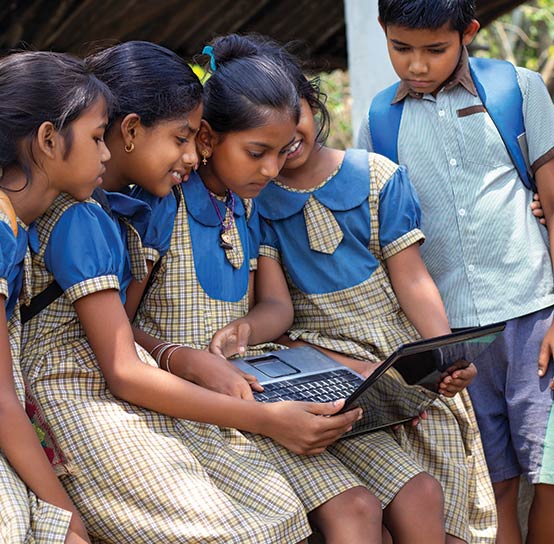-
Business Consulting
Our business consulting specialists offer a comprehensive blend of strategic advisory services. We assess the business, industry, operating model, synergy, skill sets and vision of the organisation and recommend the way forward
-
Digital Transformation Services
Grant Thornton’s digital transformation services help traditional businesses digitalise their business models with cloud technology, IoT consulting, app development and more DigiTech solutions.
-
Human Capital Consulting
Our Human Capital Consulting team harnesses technology and industry expertise to assist in constructing adaptable organisations with transparency, fostering productive and value-driven workforces, and inspiring employees to engage meaningfully in their tasks.
-
Production Linked Incentive Scheme
Production-linked Incentive Scheme by the Indian government is aimed at boosting manufacturing. Grant Thornton Bharat offers varied services across sectors to help businesses avail of this scheme.
-
Public Sector Advisory
Our Public Sector Advisory team has focused streams, aligned with the core priorities of the Government of India. We are responsible for providing innovative and customized technical and managerial solutions.
-
Tech Advisory
We have amalgamated Digital Transformation, IT Advisory & Information Management and Analytics into a new offering, DigiTech.
-
Direct Tax services
Our tax specialists offer a comprehensive blend of tax advisory, tax litigation, regulatory and compliance services, helping you navigate through complex business matters.
-
Indirect Tax Services
Get tax advisory service by leading tax firm Grant Thornton India. Our indirect tax services include advisory, compliance and litigation services for corporate, international and transaction tax
-
Transfer pricing services
Our transfer pricing services experts provide a range of services from provision of APA services to handling large global assignments including Country by Country reporting.
-
US Tax
At Grant Thornton, we help individuals and dynamic companies deal with US tax laws, which are one of the most complicated tax legislations across the world.
-
Financial Services - Tax
Best financial advisory services, tailored for small and large businesses by the experts having comprehensive knowledge of domestic laws and access to multifaceted tools to provide a valuable results.
-
Financial Reporting consulting services
Our experts have significant hands-on experience in providing IFRS/US GAAP services, end-to-end solutions and support services to fulfil financial reporting requirements.
-
Fund accounting and financial reporting
International operations often lack standardisation and have varied local reporting formats and requirements. Our experts can offer proactive insights, practical guidance, and positive progress and help meet regulatory timeframes.
-
Compliance and Secretarial Services
Our experts can assist in overhauling the entire compliance machinery of the organisation through evaluation of the applicable statutory obligations, monitoring of adequate governance controls, reporting and providing ongoing support.
-
Global People Solutions
As businesses transcend borders, both domestic and global considerations need equal attention. Our interim CFO and financial controller support services help organisations meet the business vision.
-
Finance and accounting outsourcing
Our accounting experts assist organisations in managing their accounting and reporting. Our dedicated Integrated Knowledge and Capability Centre (IKCC), allows us to service both the domestic and global markets efficiently and cost-effectively
-
Compliance Management System
We have automation solutions for you that will allow meeting government requirements and remain diligent, which when failed, can lead to penalties and loss in revenue.
-
IKCC: Grant Thornton's Shared Service Centre
The India Knowledge and Capability Centre (IKCC), aimed at delivering solutions by developing capabilities, has completed four years of its journey.
-
Global compliance and reporting solutions
At Grant Thornton Bharat, we meet the challenges of our clients and help them unlock their potential for growth. Our professionals offer solutions tailored to meet our clients’ global accounting and statutory reporting requirements. With first-hand experience of local reporting requirements in more than 145+ locations worldwide, we provide seamless and consistent international service delivery through a single point of contact.
-
Related Party Transactions Governance
Related Party Transactions Governance
-
Private Client Services
Private Client Services
-
Alerts
At Grant Thornton India, with the help of our tax alerts, we help to provide updates on how to minimise your tax exposure and risks.
-
Labour codes
Labour codes solutions help you transition through the new legislation. At Grant Thornton, we help businesses divide their approach to make sure a smooth transition.
-
Cyber
In today’s time, businesses have gone through large transformation initiatives such as adoption of digital technologies, transition to cloud, use of advanced technologies et al.
-
Governance, Risk & Operations
Our Governance, Risk and Operations (GRO) services encompass Internal Audit, Enterprise Risk Management, Internal Financial Controls, IT advisory, Standard Operating Procedures and other services.
-
Risk analytics
Grant Thornton Bharat’s CLEARR Insights is a state-of-the art data analytics platform that will help you in seamless data analysis and efficient decision-making.
-
Forensic & Investigation Services
The team of forensic advisory services experts consists of the best intelligence corporate experts, and fraud risk, computer forensic experts to deliver most effective solutions to dynamic Indian businesses.
-
ESG consulting
Grant Thornton Bharat offers holistic ESG consulting solutions for sustainable business outcomes. With industry expertise and AI technology, we drive long-term value.

-
Transaction Tax Services
Our transaction tax experts understand your business, anticipate your needs and come up with robust tax solutions that help you achieve business objectives ensuring compliance and efficiency
-
Deal Advisory
Unlike other M&A advisory firm in India, we offer deal advisory services and work exclusively with controlled and well-designed strategies to help businesses grow, expand and create value.
-
Due Diligence
Grant Thornton’s financial due diligence services are aimed at corporate looking for mergers and acquisitions, private equity firms evaluating investments and businesses/promoters considering sale/divestment.
-
Valuations
As one of the leading valuation consultants in India, Grant Thornton specializes in all the aspects of the process like business valuation services, financial reporting, tax issues, etc.
-
Overseas Listing
Overseas listing presents a perfect platform for mid-sized Indian companies with global ambitions. Grant Thornton’s team of experts in listings, work closely with clients during all stages.
-
Debt & Special Situations Solutions
Grant Thornton Bharat offers specialist debt and special situations consulting services, including restructuring, insolvency, and asset tracing solutions.
-
Financial Reporting Advisory Services
Financial Reporting Advisory Services
-
Financial Statement Audit and Attestation Services
Financial Statement Audit and Attestation Services

- Agriculture
- Asset management
- Automotive and EV
- Aviation
- Banking
- Education and ed-tech
- Energy & Renewables
- Engineering & industrial products
- FinTech
- FMCG & consumer goods
- Food processing
- Gaming
- Healthcare
- Urban infrastructure
- Insurance
- Media
- Medical devices
- Metals & Mining
- NBFC
- Pharma, bio tech & life sciences
- Real estate and REITs
- Retail & E-commerce
- Specialty chemicals
- Sports
- Technology
- Telecom
- Transportation & logistics
- Tourism & hospitality
-
India-UK
India-UK

The Organisation for Economic Co-operation and Development (OECD) had earlier released its recommendations on Base Erosion and Profit Shifting (BEPS) Action Plan 1, to address tax challenges of digitisation of the economy.
Based on these recommendations, India was one of the first countries, to introduce digital tax under its domestic law. This was a unilateral step to tax digital transactions and was meant to be an interim measure in the absence of a global consensus-based solution.
Digital tax was introduced in 2016 in India in form of a 6% levy on online advertising. Finance Act 2020 further expanded its scope and introduced Equalisation Levy (EL 2.0) of 2% on payment for e-commerce supply of goods or services, provided or facilitated by non-resident e-commerce operators.
Key challenges
It has been two years since the introduction of EL 2.0, however, stakeholders are still grappling with many unresolved issues that require clarity.
It is pertinent to note that some of the words and phrases have not been defined, thereby leaving room for different interpretations, and possible disputes and litigation in future. For example, who is an e-commerce operator? Under the EL 2.0 provisions, it means a non-resident who "owns, operates or manages" "digital" or "electronic facility" or "platform" for online sale of goods or online provision of services or both. These key terms, which are critical for the effective implementation of this levy, are not defined.
Another important issue is the scope and coverage of these provisions. One school of thought is that current provisions are wide enough to cover the sale of goods or services carried out through telephonic medium or through e-mail or for that matter, physical import of goods. The other school of thought seems to suggest the opposite.
There is no specific carve-out for the intra-group cost recharges, reimbursements, and similar transactions, which are common transactions in large business groups. In addition, the due date of payment of EL 2.0 for the last quarter is March 31, which makes compliance practically difficult and administratively inconvenient. Thus, these are some of the issues that require attention and clarity.
Global developments
Recently, the OECD/G20 nations have agreed to a two-pillar solution to address the tax challenges arising on account of the digital economy and evolving business models.
Of which, Pillar One seeks to re-allocate taxation rights to market jurisdictions where consumers/users are based.
This has been a long-standing demand of countries like India which have been seeking taxation rights based on the market potential it offers for global digital companies, irrespective of such companies having no or limited physical presence in India.
These provisions are expected to be implemented over the next two years and will necessitate phasing out of unilateral digital taxes like the Equalisation Levy.
Last year, United States Trade Representative (USTR) had proposed to impose additional tariffs of up to 25% ad valorem on Indian goods on the premise that India's EL 2.0 is discriminatory, unreasonable, and burdens or restricts US commerce.
In November 2021, an agreement was reached to suspend this additional tariff till the implementation of Pillar One or March 31, 2024, whichever is earlier.
Under this arrangement, it is expected that the US companies may get credit for EL 2.0 accrued during the interim period (i.e. 1 April 2022 till implementation of Pillar One or March 31, 2024, whichever is earlier) against future taxes as per Pillar One. The terms of this agreement are to be finalised soon.
Way forward
The EL. 2.0 digital tax is here to stay for some time, till Pillar One is implemented globally. All eyes are on Budget 2022, to see if it lays out the roadmap for India's plans for phasing out of EL 2.0 provisions and granting credit against Pillar One liability.
Even if these changes are not brought in this year's Budget, at least clarity should be provided on some of the interpretational issues being faced by taxpayers as highlighted above.
Since EL 2.0 is an interim measure, it should remain so without adding to the disputes and litigation, which could be easily avoided through appropriate clarifications, and this year's Budget is a good opportunity to address some of these issues.
This article was originally published on Business Today.
